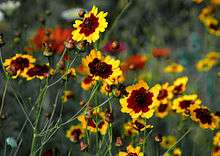Plains coreopsis
| Plains coreopsis Coreopsis tinctoria | |
|---|---|
 | |
| Scientific classification | |
| Kingdom: | Plantae |
| (unranked): | Angiosperms |
| (unranked): | Eudicots |
| (unranked): | Asterids |
| Order: | Asterales |
| Family: | Asteraceae |
| Genus: | Coreopsis |
| Species: | C. tinctoria |
| Binomial name | |
| Coreopsis tinctoria Nutt. | |
| Synonyms[1] | |
|
Synonymy
| |
| Wikimedia Commons has media related to Coreopsis tinctoria. |
Plains coreopsis, garden tickseed,[2] golden tickseed, [3] or calliopsis, Coreopsis tinctoria, is an annual forb. The plant is common to Canada (from Quebec to British Columbia), Northeast Mexico (Coahuila, Nuevo León, Tamaulipas), and much of the United States, especially the Great Plains and Southern states where it is often called "calliopsis."[4][5] The species is also widely cultivated in and naturalized in China.[6]
It often grows in disturbed areas such as roadsides and cultivated fields.[7]
Description
Growing quickly, Coreopsis tinctoria plants attain heights of 12 to 40 inches (30–100 cm). Leaves are pinnately-divided, glabrous and tending to thin at the top of the plant where numerous 1- to 1.5-inch (2.5-to 4-cm) flower heads sit atop slender stems.[8]
Flower heads are brilliant yellow with maroon or brown disc florets of various sizes. Flowering typically occurs in mid-summer. The small, slender seeds germinate in fall (overwintering as a low rosette) or early spring.[8]
Uses
The Zuni people use the blossoms of the tinctoria variety to make a mahogany red dye for yarn.[9] This variety was formerly used to make a hot beverage until the introduction of coffee by traders.[10] Women also use a infusion of whole plant of this variety, except for the root if they desire female babies.[11]
Cultivation
Plains coreopsis is cultivated as an ornamental plant for gardens, and as a native plant for wildlife gardens and natural landscaping. It grows well in many types of soil, but seems to prefer sandy or well-drained soils. Although somewhat drought-tolerant, naturally growing plants are usually found in areas with regular rainfall. Preferring full sun, it will also grow in partial shade.[12]
- Cultivars
Because of its easy growing habits and the bright, showy flowers of cultivars such as 'Roulettte' (tiger stripes of gold on a deep mahogany ground), plains coreopsis is increasingly used for landscape beautification and in flower gardens.[12]
References
- ↑ The Plant List, Coreopsis tinctoria Nutt.
- ↑ "BSBI List 2007". Botanical Society of Britain and Ireland. Archived from the original (xls) on 2015-02-25. Retrieved 2014-10-17.
- ↑ "Coreopsis tinctoria". Natural Resources Conservation Service PLANTS Database. USDA. Retrieved 17 January 2016.
- ↑ Biota of North America Program 2014 county distribution map
- ↑ A biosystematic study of Coreopsis tinctoria and C. cardaminefolia (Compositae). Edwin B. Smith and Hampton M. Parker, Brittonia, Volume 23, Number 2, pages 161-170, doi:10.2307/2805432
- ↑ Flora of China, 两色金鸡菊 liang se jin ji ju Coreopsis tinctoria Nuttall
- ↑ Everitt, J.H.; Lonard, R.L.; Little, C.R. (2007). Weeds in South Texas and Northern Mexico. Lubbock: Texas Tech University Press. ISBN 0-89672-614-2
- 1 2 Flora of North America, Coreopsis tinctoria Nuttall, J. Acad. Nat. Sci. Philadelphia. 2: 114. 1821.
- ↑ Stevenson, Matilda Coxe 1915 Ethnobotany of the Zuni Indians. SI-BAE Annual Report #30 (p.80)
- ↑ Stevenson, p.66
- ↑ Stevenson, p.84
- 1 2 Pink, A. (2004). Gardening for the Million. Project Gutenberg Literary Archive Foundation.
External links
- United States Department of Agriculture Plant Conservation Service: Coreopsis tinctoria
- Oklahoma State University, Forest & Pasture Management
| Wikispecies has information related to: Coreopsis tinctoria |